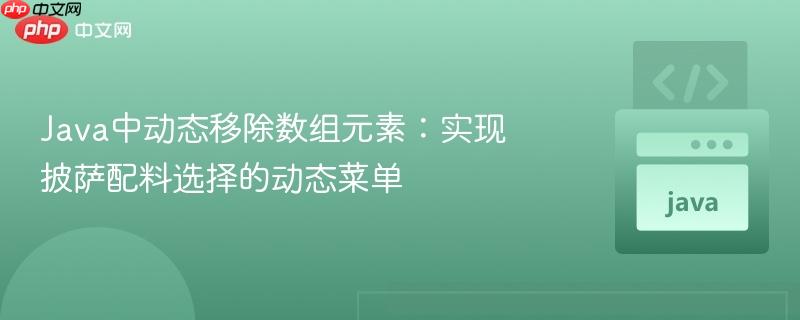
本文旨在解决Java中动态移除数组元素的问题,特别是针对类似披萨配料选择这种需要在循环中更新菜单的情况。文章将介绍三种方法:使用ArrayList动态数组、手动实现数组元素移除功能以及通过标记隐藏数组元素,并提供相应的代码示例,帮助开发者根据实际需求选择最合适的解决方案。
在Java编程中,数组一旦创建,其长度就固定不变。这在某些场景下会带来不便,例如在构建动态菜单时,需要根据用户的选择实时更新菜单选项。本教程将探讨几种在Java中实现类似“移除”数组元素效果的方法,并以披萨配料选择为例进行说明。
ArrayList 是 Java 集合框架中的一个类,它实现了可变大小的数组。使用 ArrayList 可以方便地添加、删除元素,而无需手动管理数组的大小。
示例代码:
立即学习“Java免费学习笔记(深入)”;
import java.util.ArrayList;
import java.util.Scanner;
public class PizzaToppings {
public static void main(String[] args) {
Scanner scanner = new Scanner(System.in);
ArrayList<String> toppings = new ArrayList<>();
toppings.add("diced onion");
toppings.add("green pepper");
toppings.add("pepperoni");
toppings.add("sliced mushrooms");
toppings.add("jalapenos");
toppings.add("pineapple");
toppings.add("dry red pepper");
toppings.add("basil");
char userChar = 'y';
while (userChar == 'y') {
System.out.println("\nChoose your favorite toppings:");
for (int i = 0; i < toppings.size(); i++) {
System.out.println((char)('A' + i) + ". " + toppings.get(i));
}
System.out.println("\nEnter a choice: ");
String userTopping = scanner.nextLine();
if (userTopping.length() == 1 && Character.isLetter(userTopping.charAt(0))) {
int index = Character.toUpperCase(userTopping.charAt(0)) - 'A';
if (index >= 0 && index < toppings.size()) {
System.out.println("You chose: " + toppings.get(index));
toppings.remove(index); // 移除已选择的配料
System.out.println("Would you like to add more toppings? (Y/N)");
userChar = scanner.nextLine().charAt(0);
} else {
System.out.println("Invalid topping choice.");
}
} else {
System.out.println("Invalid input.");
}
}
System.out.println("\nYour pizza will have the following toppings:");
// 打印剩余的配料
}
}注意事项:
如果出于某些原因无法使用 ArrayList,可以手动实现数组元素移除的功能。这通常涉及创建一个新的数组,并将原始数组中不需要移除的元素复制到新数组中。
示例代码:
立即学习“Java免费学习笔记(深入)”;
public static String[] removeElement(String[] array, int index) {
String[] temp = new String[array.length - 1];
for (int i = 0, j = 0; i < array.length; i++) {
if (i != index) {
temp[j++] = array[i];
}
}
return temp;
}
// 使用示例
String[] toppings = {"diced onion", "green pepper", "pepperoni"};
toppings = removeElement(toppings, 1); // 移除索引为1的元素 (green pepper)注意事项:
另一种方法不是真正地移除数组元素,而是通过某种方式将其“隐藏”起来,例如将其设置为 null 或使用一个额外的数组来记录需要隐藏的元素的索引。
示例代码:
立即学习“Java免费学习笔记(深入)”;
String[] toppings = {"diced onion", "green pepper", "pepperoni"};
boolean[] isHidden = {false, false, false}; // 初始时所有元素都可见
// 隐藏索引为1的元素
isHidden[1] = true;
// 打印数组,跳过隐藏的元素
for (int i = 0; i < toppings.length; i++) {
if (!isHidden[i]) {
System.out.println(toppings[i]);
}
}注意事项:
本教程介绍了三种在 Java 中实现类似“移除”数组元素效果的方法:使用 ArrayList 动态数组、手动实现数组元素移除功能以及隐藏数组元素。选择哪种方法取决于具体的应用场景和性能需求。ArrayList 通常是首选方案,因为它提供了方便的 API 和较好的性能。如果无法使用 ArrayList,可以考虑手动实现数组元素移除功能或隐藏数组元素。在选择方法时,需要权衡内存占用、性能和代码复杂度等因素。
以上就是Java中动态移除数组元素:实现披萨配料选择的动态菜单的详细内容,更多请关注php中文网其它相关文章!

每个人都需要一台速度更快、更稳定的 PC。随着时间的推移,垃圾文件、旧注册表数据和不必要的后台进程会占用资源并降低性能。幸运的是,许多工具可以让 Windows 保持平稳运行。

Copyright 2014-2025 https://www.php.cn/ All Rights Reserved | php.cn | 湘ICP备2023035733号